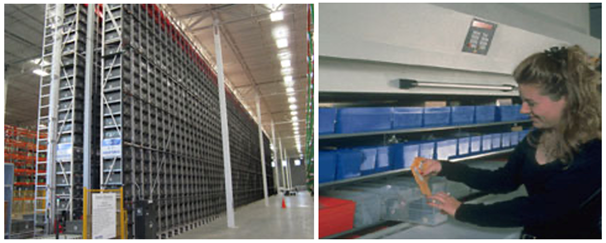Life sciences sector companies are facing huge supply chain challenges with commercial, operational, and strict regulatory factors contributing to creating a unique production environment. These include the necessity to supply very high service levels, products tracking and tracing to avoid both errors and counterfeiting and therefore the got to suits regulations which may vary greatly between countries or states.
Therefore, the power to know and manage inventory is crucial to delivering to customers and containing costs. Inventory optimization can be actualised with the implementation of the warehouse technologies as discussed below.
Table of Contents
Warehouse Management System (WMS)
WMS is designed to optimize warehouse operations and functions. These systems facilitate inventory management personnel in their daily planning, organizing, staffing, directing, and controlling the use of obtainable resources, to manoeuvre and store materials into, within, and out of a warehouse. The WMS receives orders from the overlying host system, mostly an Enterprise Resource Planning (ERP) system.
Then orders are managed in the database and, after appropriate optimization, supplied to the connected conveyor control systems. Within the process, WMS has made many warehouse activities faster for people to perform and generated efficiencies to scale back labour-intensiveness.

Radio-Frequency Identification (RFID) system
RFID is a system that used to transmit product identity wirelessly in the form of a unique serial number. The RFID system is consists of two parts – electronic devices called readers that transmit radio signals and label-like tags with a little amount of data in them, usually just a unique serial number. When the reader’s radio wave hits the tags, the tag can reflect a sign with its serial number. In this way, the reader can identify all the tags within a brief distance, usually a couple of meters. Additionally to having the ability to spot and count all of the tags within the vicinity, some readers can estimate the situation of the tag.
Operations in warehousing such as planning and warehouse facilities control have become more complex. The logistics activities such as storage, sorting, and cycle counting requires high concentration and are labour-intensive. The implementation of RFID could help to improve warehouse and labour utilisation, reduce errors and wrong identification which in turn increase productivity and profitability. RFID in conjunction with a WMS is an effective real-time system that assisting in supply chains management and operational flows such as goods receiving, picking, checking, and delivery. In a result, the cost is reduced by improving visibility into warehouse management system.

Automation Technology
Life sciences product manufacturers and distributors are continuously being challenged to extend output while improving operational efficiency. Hence, automation technology is widely utilized in the industry.Warehouse design is playing a critical role to realize the goal. However, setting the framework for the life sciences industry are the strict quality and safety standards.With the strict requirements and industry standards, manufacturers and distributors must closely follow with all the details within the production and distribution process. Inventory management in the life sciences industry is a crucial element. Life sciences products such as biomedical devices and pharmaceuticals are sensitive products that have a high risk to human health and life. Automation via an automatic storage and retrieval system (AS/RS) increases the speed that products are moved in and out of the warehouse, providing increased productivity.

Automated Storage and Retrieval Systems (AS/RS)
Automated storage and retrieval systems (ASRS or AS/RS) consist of a variety of computer-controlled systems that automatically load and unload from storage locations within a warehouse facility with precision, accuracy, and speed. An ASRS System is a combination of kit and controls that could handle, store, and retrieve materials as required with precision, accuracy, and speed under an outlined degree of automation. Systems vary from smaller automated systems to larger computer controlled storage/retrieval systems that are integrated into the production and/or distribution process.

Automated storage and retrieval systems are utilized in many areas to support processing and picking throughout a facility such as order picking, storage, kitting, consolidation, assembly, production, and replenishment. AS/RS has benefits including increases of throughput capabilities and process accuracy, delivering items to the operator at a convenient height, eliminating time lost to walking, searching, lifting, bending, and twisting activities. It also provides the highest possible storage density and real-time inventory control. By implementing ASRS, the warehouse could save floor space and increases labour productivity.
The full content is only visible to SIPMM members
Already a member? Please Login to continue reading.
References
Ann Chong Fong Ting, DPSM. (2018). “Warehouse Technologies for Effective Inventory Control”. Retrieved from SIPMM: https://publication.sipmm.edu.sg/warehouse-technologies-effective-inventory-control/, accessed 05/12/2020.
ClarusWMS. (2017).“RFID Benefits in Warehouse Management Systems”. Retrieved from https://www.claruswms.co.uk/rfid-benefits-wms/, accessed 05/12/2020.
Hector Sunol. (2020). “Warehouse Digitalization: The Future of Warehousing”. Retrieved from https://articles.cyzerg.com/warehouse-digitalization-the-future-of-warehousing,accessed 05/12/2020.
M. Nurahim Bin M. Masruri, GDLM. (2017). “Innovative Technologies for Warehouse Implementation”.Retrieved from SIPMM: https://publication.sipmm.edu.sg/innovative-technologies-warehouse-implementation/, accessed 05/12/2020.
Rick Chua Chee Hack, DPSM. (2019). “Technologies for Effective Pharmaceutical Warehousing”.Retrieved from SIPMM: https://publication.sipmm.edu.sg/technologies-effective-pharmaceutical-warehousing/, accessed 05/12/2020.
Stephen Laaper. (2017). “The digital edge in life sciences”. Retrieved from: https://www2.deloitte.com/content/dam/Deloitte/us/Documents/process-and-operations/us-cons-business-case-digital-supply-networks-life-sciences.pdf, accessed 05/12/2020.
Tom Snoxell. “Inventory Optimization in Life Sciences Industry”. Retrieved from https://www.tefen.com/insights/industries/Life_Sciences/inventory_optimization_in_life_sciences_industry, accessed 05/12/2020.
Wong Yoke Foong, DLM. (2018) “Current Technology in Use for a Typical Warehouse”. Retrieved from SIPMM: https://publication.sipmm.edu.sg/current-technology-in-use-for-a-typical-warehouse, accessed 05/12/2020.

